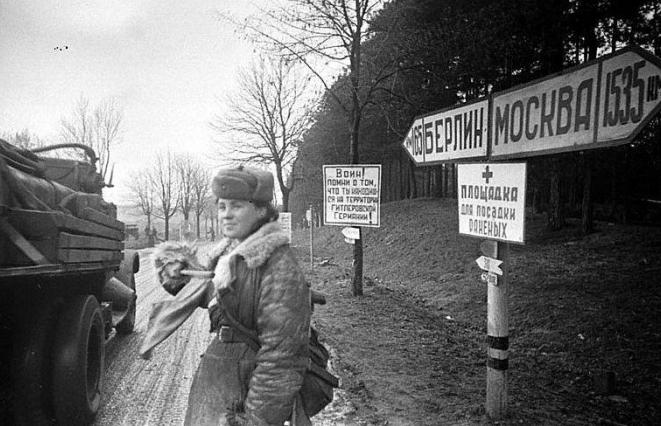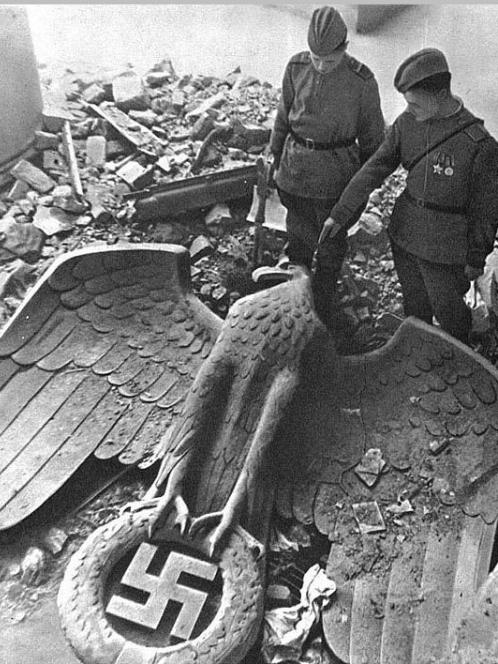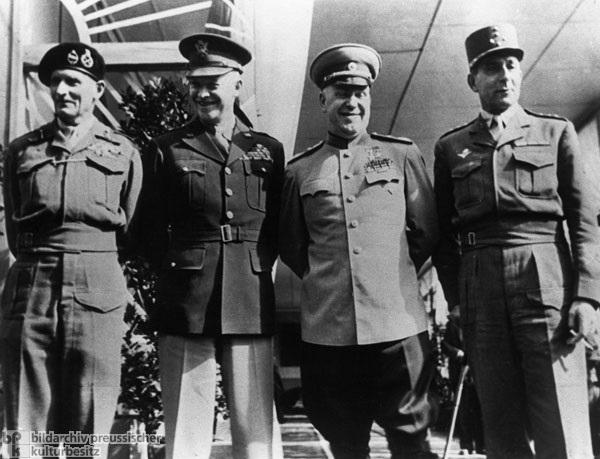May 9, 1945 - this date is familiar to every resident of modern Russia and the post-Soviet space as the day of the Great Victory over fascism. Unfortunately, historical facts are not always unambiguous, this is what allows some historians of Western Europe to distort events. The signing of the act of unconditional surrender of Germany occurred a little differently than we all know from history textbooks, but this should not change the idea of the course and results of that bloody war.
Offensive
Since the winter of 43-44, the Red Army drove the Germans to the border on all fronts. Fierce battles exhausted the enemy’s forces, but also created difficulties for the Soviet soldiers. The liberation of Karelia, Belarus, Ukraine, Poland, Bulgaria, Yugoslavia occurred during 1944, the Red Army reached the borders of the country of the aggressor. The signing of the act of unconditional surrender of Germany is yet to come, the troops exhausted by miles of march need to regroup for a decisive battle. The capture of Berlin became a matter of prestige for our country, and the allies of the anti-Hitler coalition also strove for this. January 1945 was a moment of non-return for the Nazis, the war was completely lost, but their resistance at the approaches to Berlin became even more violent. The creation of many fortified areas, the reorganization of army units, the pulling of divisions to the eastern front - these steps Hitler takes in order to stop the Soviet troops. In part, he manages to delay the attack on Berlin, it is postponed from February to April 1945. The operation is carefully planned and prepared, all possible reserves and weapons are pulled to the advancing fronts. From April 16 to April 17, 1945, an attack on the German capital begins with the forces of two fronts - the first Belorussian (Marshal Zhukov Georgy Konstantinovich) and the first Ukrainian (Ch. Commander Konev Ivan Stepanovich), the second Belorussian Front (Rokossovsky Konstantin Konstantinovich) should encircle the city and prevent breakthrough attempts. As if these terrible four years of the war were not there, the wounded stood up and marched on Berlin, despite the fierce resistance of the Nazis, swept away the fortifications, everyone knew that this was the path to victory. Only by noon on May 2, 45, the capital of the Third Reich fell into complete silence, the remains of the garrison surrendered and Soviet banners replaced the swastika on the remains of the destroyed buildings.

Allies
In the summer of 1944, a mass offensive of the allied forces in the western direction began. It is due, first of all, to the too rapid onslaught of the Red Army along the entire length of the eastern front line. The Norman landing, strategic bombing of the main industrial areas of the Third Reich, military operations in Belgium, France and Germany significantly complicate the situation of Nazi Germany. The seizure of the territory of the Ruhr region, the south of Austria, makes it possible to attack the aggressor inland. The legendary meeting of Soviet and Allied forces on the Elba River in April 45 is actually the last step in the war. The surrender of fascist Germany is becoming a matter of time, all the more so since it has already partially begun by some Wehrmacht armies. From a political point of view, the capture of Berlin was necessary for the Allies as well as the USSR, Eisenhower repeatedly mentions this. For the combined parts of the British, Americans and Canadians, the conduct of this offensive operation was theoretically possible. After the unsuccessful Ardennes counterattack, German troops retreat almost all along the front without fierce fighting, trying to throw combat-ready formations to the east. Hitler actually turned his back on the allies of the USSR, directing all efforts to stop the Red Army. The second front was moving very slowly, the command of coalition formations did not want large losses among their soldiers during the assault on well-fortified Berlin and its suburbs.

Germans
Hitler until the very end was waiting for a coalition split and changes on the front line. He was sure that the meeting of the Allies would turn into a new war against the USSR. When his expectations were not met, he decided to make peace with the USA and Great Britain, which would make it possible to close the second front. Negotiations were frustrated thanks to timely intelligence from the Soviet Union. This fact significantly accelerated the process of advance of the Red Army and prevented the possibility of concluding a separate peace. The Allies had to decisively insist on compliance with all the Yalta agreements, which included the signing of the act of unconditional surrender of Germany. Hitler was ready to “surrender” Berlin to the Anglo-American troops; he failed to do this thanks to the Soviet command. The offensive and assault on the capital of the Third Reich became a matter of honor for our troops. The fascists defended themselves fanatically, there was nowhere to retreat, the approaches to the city became powerful fortified areas.
Yalta Conference
Massive offensive operations on the eastern and western front made it clear to the Nazis that the complete surrender of Germany was already close. 1945 (its beginning) did not leave Hitler a chance to win and an opportunity to wage a protracted war in both directions. The anti-Hitler coalition understood the importance of an agreed peaceful solution to territorial and political transformations in a liberated Europe. Representatives of the highest level of the three Allied powers gathered in Yalta in February 1945. Stalin, Roosevelt and Churchill determined the future not only of Germany, Poland, Italy, France, they created a new bipolar device in Europe, which was observed over the next 40 years. Of course, under the prevailing conditions, none of the countries could dictate their own conditions, therefore the results of this historic conference partially satisfied the demands of the leaders. But the main issue was the destruction of fascism and nationalism, the danger of such ruling regimes was recognized by all participants.

Document preparation
The signing of the act of unconditional surrender of Germany took place in 1945, but back in 1943 the draft of this document was agreed upon by all countries of the anti-Hitler coalition. Roosevelt became the initiator of its creation, the document itself was drafted with the participation of an advisory commission consisting of European experts. The text of the project was quite extensive and was rather advisory in nature, therefore, in fact, the surrender of Germany was signed after the compilation of a completely different document. American officers approached its compilation from a military, purely pragmatic side. Six paragraphs of the document contained specific requirements, specific dates and procedures in case of violation of any article, which were historical.
Partial surrender
Several large military units of the Wehrmacht surrendered to the Allied forces before an agreement was signed on the complete surrender of the Nazis. German groups and entire armies sought to break through to the west so as not to fight with the Russians. Their command realized that the war was over, and they can only get asylum by surrendering to the Americans and the British. Especially the groups of SS troops, famous for the atrocities on the territory of the USSR, fled from the rapidly advancing Russians. The first case of surrender was recorded on April 29, 1945 in Italy. On May 2, the Berlin garrison surrendered to the Soviet troops, on May 4, the naval forces of Germany in Denmark and the Netherlands laid down their arms in front of the British, on May 5, Army Group G surrendered, reaching the Americans from Austria.
First document
May 8, 1945 - this is the date in Europe that is considered Victory Day over fascism. It was not chosen by chance; in fact, representatives of the new German government signed the surrender on May 7, and the document was due to take effect the next day. Admiral Friedeburg as part of the German delegation arrived in the Rhine, where the headquarters of Eisenhower was based with the proposal of surrender on May 5, 1945. The Nazis began to bargain with the Allies on the terms of the document, trying to delay time and withdraw as many troops and civilians as possible out of the western front line, while not stopping attempts to deter the Soviet army in the eastern direction. Eisenhower completely rejected all the arguments of the Germans, insisting on the complete and unconditional surrender of Germany and the signing of the document by all parties to the conflict. On May 6, representatives of all allied forces were called to the Rhine. The Soviet history textbooks did not reflect who signed the act of surrender of Germany in the first version, but the names of these people remained: from the USSR - General Susloparov, from the combined forces of the allies - General Smith, from Germany - General Jodl, Admiral Friedeburg.

Stalin
Ivan Alekseevich Susloparov was a member of the Soviet mission at the headquarters of the allies, therefore, before putting his signature on a historical document, he transferred the information to Moscow. The answer came belatedly, but its fourth point implied the possibility of making changes to the original version, which Stalin took advantage of. He insisted on re-signing the act, the following arguments were given as arguments:
- After signing the surrender, the Nazis continued to conduct active defensive military operations on the eastern front.
- Stalin attached great importance to where the capitulation of Germany was signed. For this, in his opinion, only the capital of the defeated state is suitable.
- Susloparov did not have the authority to sign this document.
The allies agreed with his opinion, especially since in fact it was a repetition of the procedure, which did not change its essence.
Capitulation of Germany
The date of ratification of the previous treaty was set for May 8, 1945. At 22 hours 43 minutes European time, the procedure for signing the surrender was completed, in Moscow it was already the next day. That is why on the morning of May 9 in the territory of the USSR, the end of the war and the complete defeat of Nazi Germany were announced. In fact, the document was signed without significant changes, from the Soviet command it was signed by Marshal Zhukov Georgy Konstantinovich, from the Allied forces - Marshal Arthur Tedder, from Germany - the Supreme Commander of the Wehrmacht Wilhelm Keitel, Colonel General of the Luftwaffe Stumpf, Navy Admiral Friedeburg. Witnesses were General Latré de Tassigny (France), General Spaats (USA).
Hostilities
Many fascist groups did not recognize surrender and continued to resist the Soviet troops (in Austria and Czechoslovakia), hoping to break through to the west and surrender to the Allies. Such attempts were suppressed by the destruction of enemy groups, so actual military operations were carried out on the eastern front until May 19, 1945. About 1,500 thousand German soldiers and 100 generals surrendered to Soviet troops after May 8. The number of individual clashes was significant, scattered enemy groups often resisted our soldiers, so the list of those killed in this terrible war is not limited to the date of May 9. The conclusion of peace between the main parties to the conflict did not happen at the time of signing the act of "surrender of Germany." The date that will put an end to the military confrontation will come only in June 1945. At this time, a document will be drawn up and signed, which is based on the principle of post-war government.
Victory
Levitan announced the end of World War II on May 9, 1945. This day is the celebration of the Victory of the Soviet multinational people over fascist Germany. And then, and now it doesn’t matter what date the capitulation was signed, 7 or 8, the main thing is the fact of signing the document. Many peoples suffered in this war, but the Russians will always be proud that they were not broken and liberated their homeland and part of Europe. The victory was difficult, costing many millions of lives, and the duty of every modern person is to prevent the recurrence of such a tragedy. The act of unconditional surrender of Germany was signed twice, but the significance of this document is unambiguous.